Recommended Varieties/Cultivars
It's always best to select varieties that do well in the area in which you live. If you live in a warm inland valley, select heat-tolerant and slow-bolting varieties such as Black Seeded Simpson, Salad Bowl Blend, Red Sails, Royal Oak Leaf, and Red Deer Tongue. Black Seeded Simpson, Grand Rapids, Red Oakleaf, and Ruby. If you live in a cooler area, such along the coast, you live in an ideal lettuce-growing area and may select from a wide selection of varieties, including Black Seeded Simpson, Grand Rapids, Red Oakleaf, and Ruby.
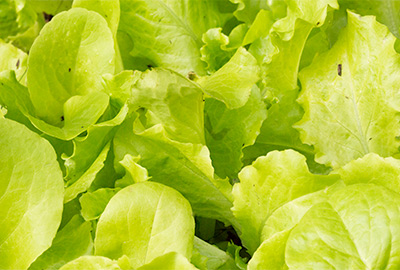
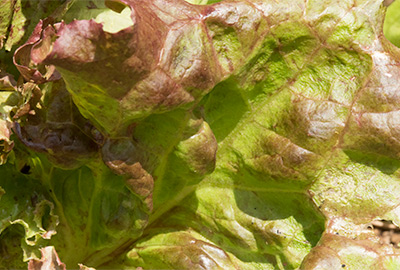
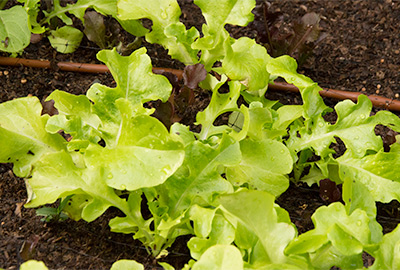
Buying/Selection Tips
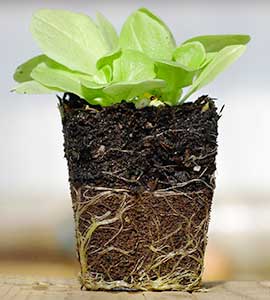
Many local nurseries may sell lettuce starts that are not ideal for your area. Know the variety and confirm heat and cold tolerance before purchasing starts. Beware of rootbound lettuce starts! When buying starts, tap the pots, cells, or containers to loosen the rootballs and look at roots. Some visible roots, a freckling of white roots at the edges of rootballs, or a fine net of roots are acceptable; overgrown, circling, or layered roots at pot edges and bottoms are not, and may result in slow-growing, stunted, or stressed plants. Smaller lettuce starts of 1.5 to 2.5 inches tall may be less rootbound and may outperform larger starts after transplant.
Soil Needs/Tip
Prefers loose, reasonably fertile soil. Lettuce is a light feeder that thrives in a wide range of soils. Soil pH between about 6.2 and 6.9 is recommended, and soil pH is generally more important for lettuce than soil type or texture. Lettuce will underperform, fail, or may produce small, chlorotic, or impalatable leaves in alkaline soils above 7.0 pH, in acidic soils below about 5.8 pH, or in compacted soils.
Suitable Microclimate
Lettuce prefers full sun in daytime temperatures of 70° F to 75° F, and may suffer, bolt, or become bitter above 80° F, during longer summer days, and during shorter, colder fall and winter days. At 85° F to 90° F temperatures and above, virtually all varieties of lettuce will suffer, become bitter, or bolt in from a few days to 2 to 3 weeks. To extend harvest, use shadecloth during warm weather, or plant in a location that is shaded during summer afternoons. To protect from frost during winter months, use fabric or plastic sheets, or plant in a location that is protected from frosts during cold winter weather.
Getting Started
In many areas along the California coast and in some temperate inland areas, lettuce can be grown outdoors all year. In warmer inland valleys, lettuce is typically grown from late winter through June or until heatwaves begin in summer, and from early fall after heat breaks throughout the fall and early winter. In the coldest areas of California, lettuce is grown in the summer, from the last frost in the spring to the first frost in the fall.
Watering Tips
Lettuce naturally develops shallow root systems and needs more frequent watering than many other vegetables. Water progressively more deeply and less frequently to help lettuce grow deeper roots and resist warm weather, which may extend harvest. GardenZeus recommends maintaining soil moisture to avoid any wilting whatsoever as much as possible in lettuce, as plants can bolt or turn bitter after repeated wilting, especially severe wilting, and especially during long days of summer or short fall-and-winter days.
Planting Method/Tips
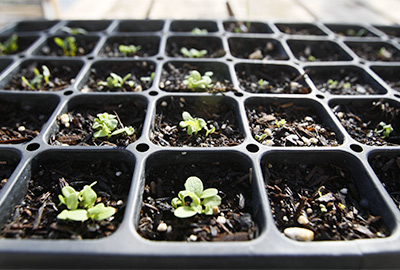
Spread roots of starts gently outward and downward to encourage a deep, spreading root system. While some experts recommend tearing off excess roots at transplanting, at GardenZeus, we prefer to minimize damage to lettuce roots during transplant. Plant slightly deeper than the level at which starts were in packs or pots. Start seeds indoors 2 to 3 weeks before planting; allowing lettuce to go too long in small pots may result in rootbound, slow-growing, stunted, or less-vigorous adult plants. Seeds can be broadcast outdoors and covered with a very thin (1/8-inch or less) layer of fine soil or sand. Broadcasted seeds must be kept moist for germination, which may require misting or watering with a gentle, fine spray a few to several times per day. Lettuce does not germinate well when in complete darkness or when buried under more than a very thin layer of soil. If broadcasting, use thinned baby plants for early salads. Lettuce germinates best with cool nights (55° F) and warm days (70 to 80° F).
Spacing
If growing to full heads, plant at least 4 inches apart; 6 inches may be better for experienced gardeners who know their growing conditions and are confidently able to grow full heads of lettuce. For earlier, larger, and extended harvest, GardenZeus recommends planting looseleaf lettuce 2 to 4 inches inches apart and both thinning entire plants and harvesting outer leaves as needed rather than waiting to harvest entire heads of lettuce. At GardenZeus we err on the side of planting lettuce plants "too close" together, then using thinned plants for early salads, sandwiches, and garnishes.
Timelines
18 hours to 14 days or longer to seed germination.
1 to 3 weeks from germination to transplant.
Early harvest of smaller leaves and thinned plants may begin within 15 to 30 days of germination.
50 to 80 days from germination to harvest of full heads depending upon variety and growing conditions.
Pollination Needs/Tips
Because we eat the leaves of lettuce plants, we prefer slow flowering (slow bolting) in lettuce, and are not concerned with pollination unless saving seeds. Lettuce produces perfect, self-pollinated flowers, and is one of the most reliable self-pollinating vegetables.
Interplanting/Companion Planting
Lettuce has few antagonist plants in the vegetable garden, and does well when planted with many other vegetables. GardenZeus recommends planting with root vegetables such as radishes and carrots, or in open spots in your strawberry beds. Planted sparsely among more dense onions or other alliums may provide mild discouragement for slug, snails, and insect pests.
Nutrient/Amendment/Fertilization Needs/Tips
Lettuce is one of the least demanding vegetables for soil nutrients. As nitrogen is usually the limiting nutrient in growth of lettuce, GardenZeus recommends adding nitrogen in the form of diluted urea or a cup of chicken manure diluted in 4 gallons of water (half cup if fresh manure) and mixed thoroughly about one to four times per month when actively harvesting outer lettuce leaves. Adding too much nitrogen or overly rapid growth of high-nitrogen leaves may result in insect infestation.
Mulching
Use a quarter to half-inch fine mulch for small starts under 4 inches in height; increase to half-an-inch or more of fine to medium mulch after plants are 6 to 10 inches tall.
Pruning/Cutting Back/Pinching/Separating
GardenZeus recommends harvesting outer leaves of looseleaf lettuce as needed, which allows the plant to produce new leaves over an extended period from the growing point at the plant's center. Thinning plants may be needed, but lettuce is normally not otherwise cut back except at harvest of full heads.
Propagating
From seed. GardenZeus generally recommends open-pollinated, untreated, organically grown seeds.
Container Gardening
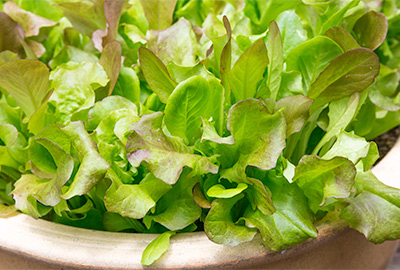
Looseleaf lettuce is an ideal plant for container gardening, and can be planted in spot areas in containers with other plants, such as at the edge of a tomato pot or among root crops as they are harvested. Containers allow you to move lettuce to follow seasonal changes in sun, to shaded areas during hot summers, warmer areas during winter, and to protected areas when necessary in response to winds or other environmental factors. GardenZeus recommends 6-inch or 1-gallon nursery pots as a minimum size, with at least a 6-inch depth, for most varieties, and deeper pots are preferred. Lettuce is sensitive to drying soil, especially in warm weather, and will wilt easily, which can lead to bolting, so monitoring and regular watering of lettuce in containers is important. Self-watering containers or trays that hold a half-inch of standing water below pots may help provide consistent soil moisture. GardenZeus considers all looseleaf lettuce varieties that are otherwise appropriate for your growing conditions and time of year to be suitable for growing in containers.
Seasonal Care
Bolting in lettuce may result more from longer day length in summer and shorter day length in fall and winter rather than from heat or frost. Use shadecloth or provide shade to lettuce when daytime temperatures rise above about 78° F. Cover with sheets or plastic to minimize damage from overnight frosts.
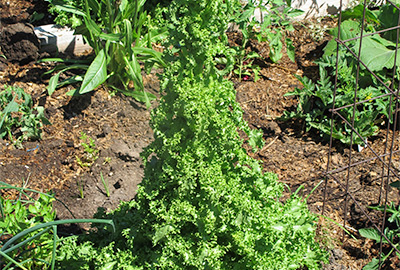
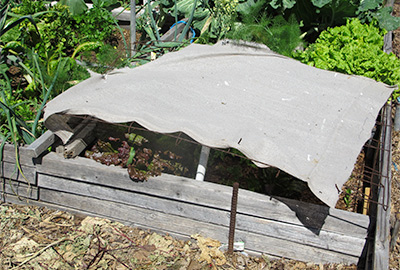
How to Harvest
Thin young plants for early salads. Use a sharp knife or garden scissors to cut the midribs of the largest, outermost leaves. To maximize total yield, Gardenzeus recommends minimal harvesting until looseleaf lettuce is 6 to 8 inches tall to avoid stunting plants by early harvest. GardenZeus recommends harvesting about 10% to 20% of lettuce leaves every 5 to 10 days from vigorous, actively growing plants. Overharvesting will significantly slow growth of new leaves because the plant is using leaf surfaces to capture the energy needed to grow new leaves.
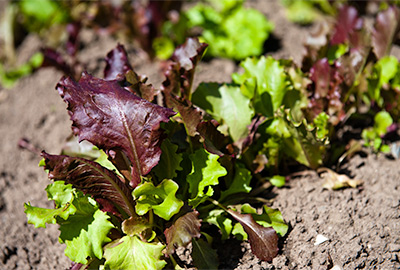
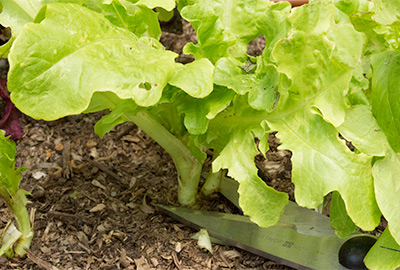
Harvesting Tips
Harvest whole heads as temperature warms consistently to 82° F or higher for a few hours per day. As plants bolt or begin to grow bitter late in the growing season, soak heads or leaves in cool water overnight to draw out white sap that is produced in leaves and stems as plants prepare to set seeds and which causes bitter flavor.
What Commonly Goes Wrong
Bolting: Lettuce may begin to flower and go to seed as a result of long or short days, hot or cold weather, repeated wilting, or other stresses. Leaves may begin to turn bitter as soon as lettuce starts to flower. There is nothing that can be done to reverse or stop bolting once it begins. GardenZeus recommends harvesting the majority of leaves or whole heads at the first sign of bolting, unless you want to save seeds.
Slow growth, lack of vigor, small plants, production of few or small leaves, yellowing leaves, dried-out or folded edges of leaves, brown or dead leaf tips or edges: These common symptoms may result from soil pH that is too high or too low, compacted soil, alkaline soil, overwatering, underwatering, irregular watering, cold weather, lack of soil nitrogen, other soil nutrient deficiencies, or a combination of these. May also be the result of too much sun, wind, or other environmental and abiotic factors. Burned leaf tips may also result from overfertilizing, sodic soils, or soluble salts in soils.
Shallow roots: In compacted clay soils that are common in new gardens in your area, lettuce may form extremely shallow root systems with plants that appear vigorous and healthy until warm weather arrives and upper soil layers heat up, after which lettuce may bolt, decline, or die rapidly. Break up compacted soil before planting, amend with compost, maintain surface mulch, and water slowly and less frequently to encourage deeper rooting.
Not a Problem
Many varieties of looseleaf lettuce have unusual color variations that may be surprising. What might appear to be discoloration, such as tinges of red or bronze, is normal in many varieties. Many varieties are also deeply lobed, or have narrow leaves, which may be mistaken for insect damage, and some varieties tend naturally to stay smaller or grow much slower than others.
Common Diseases
Damping Off: A common soilborne fungus that may suddenly kill smaller seedlings and starts. Occurs most commonly in cool, damp soils.
Schlerotinia fungi may cause brown rotting and kill plants, a condition known as "lettuce drop," especially in wet soils. Avoid planting in the same area for at least three years.
Common Pests
Common pests of lettuce in California include aphids, cutworms, earwigs or pincerbugs, sowbugs or potato bugs (especially for young starts or transplants), caterpillars, snails, slugs, grasshoppers, gophers, wild rabbits and hares, deer, and birds. Caterpillars tend to skeletonize leaves (remove all the leaf matter except veins and midribs), while slugs, snails, and earwigs tend to eat holes or ragged areas in otherwise intact leaves.
Special Care
Lettuce is an easy vegetable that is suitable for even the most inexperienced gardeners. Avoid using fertilizer unless soil deficiencies are known from a lab test, except occasional nitrogen. Lush, fast-growing plants may be susceptible to attack by aphids or other insect pests.
Special Info
It's easy to save lettuce seeds. If saving seeds, use open-pollinated (non-hybrid) varieties. Allow a few of the healthiest, slowest-bolting, most-vigorous plants to retain leaves going into warm weather. Seeds are ready when tiny flowers dry and turn semi-translucent, like tiny dandelion heads. One lettuce plant may produce thousands of viable seeds that nearly always are true to variety, meaning they grow to be like the parent plant.
Sustainable Landscaping Tip
Many varieties of looseleaf lettuce will naturalize in California, and can be grown using rain only over winter, especially in moist areas at the base of mounds or hills, or in areas that receive extra runoff during rains. A dry period without irrigation is needed during warm weather for lettuce to naturalize; lettuce seeds that are kept moist during warm late-summer and fall before rains will tend to rot.
Advanced Tip
If you live in a warm inland valley, try planting lettuce among tomatoes or other larger plants to provide partial shade and extend harvest into summer. If you live in a cold winter area of California, consider extending your growing season by starting lettuce indoors or in a cold frame.
Preservation, Storage, and Use
Freshly picked, loose leaf lettuce is highly perishable and can be expected to last no longer than two to three days even under the optimal conditions of 32° F and high humidity. For this reason, GardenZeus recommends that you do not harvest your loose leaf lettuce until you are ready to use it. Loose leaf lettuce will deteriorate even more quickly than head lettuce. It is particularly important to wash loose leaf lettuce several times before using; sand, other soil particles and, yes, even some insects and gastropods, can hide in its many nooks and crannies. Store tightly wrapped in the refrigerator in a plastic bag.
Humidity in refrigerators is too low for lettuce storage. To store loose leaf lettuce in your refrigerator, do so in a humid produce drawer with humidity turned up to full, or with an open bowl of water, and/or in a cloth or paper bag to reduce drying. Storing lettuce in high humidity is essential to preserve crispness.
Lettuce is highly sensitive to the ethylene gas produced by many fruits. Even exposure to low concentrations of ethylene gas stimulates the production of phenolic compounds which in turn leads to brown pigments in lettuce. So when putting lettuce in your refrigerator, make sure to place it far away from your ethylene-producing fruits.
A variety of freshly-harvested loose leaf lettuces is a feast for both the eye and the palate. Dress your lettuce with extra virgin olive oil, some good vinegar, a selection of herbs, sea salt, pepper and enjoy!
One cup of colorful, pigmented lettuce leaves provides almost half of the USDA recommended daily amount of Vitamin A.